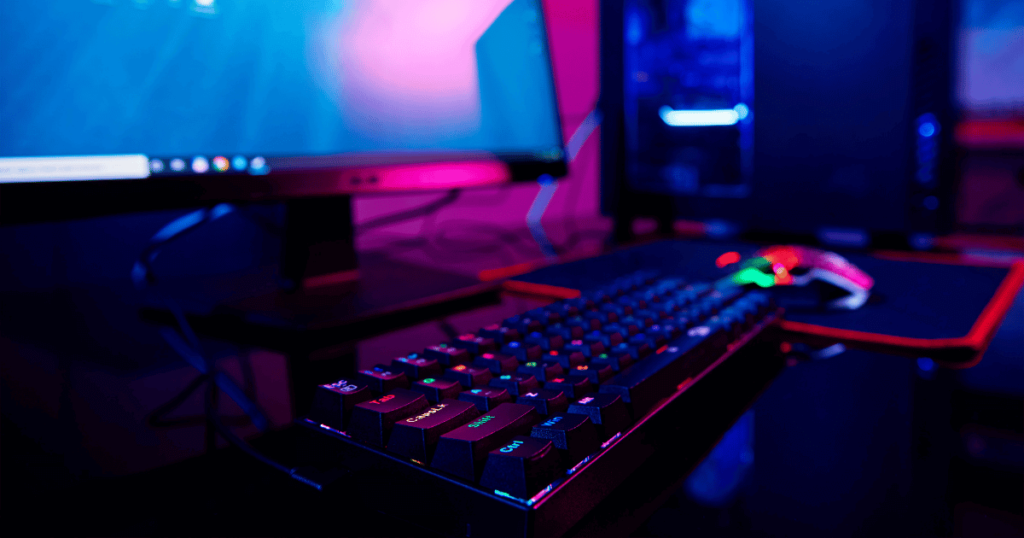Did you know there’s a keyboard that’s even more compact than TKLs, yet super powerful for what it does? It’s the 60% mechanical keyboard, a type of keyboard that skips the number pad and some other keys.
Curious about how it works and why it’s cool? Let’s jump in and learn more.
Key Takeaways
- A 60% mechanical keyboard trims down to the essentials, omitting the number pad and other infrequently used keys for a tighter setup.
- This type of keyboard typically houses 61 to 64 keys, focusing on those most crucial for everyday computer use.
- To compensate for the missing keys, functions like the number pad and F-keys are integrated into other keys, accessed with the ‘Fn’ key combo.
- The compact design is a hit with some gamers and typists who prize desk real estate and efficiency, though it may require an adjustment period.
- 60% keyboards also feature customizable options, including various switch types for a tailored typing feel.
The Name Behind the Compact Design
The term “60% keyboard” is pretty straightforward—it refers to a keyboard that’s roughly 60% of the size of a full-size keyboard. These compact versions trim down the key count, usually to somewhere between 61 and 64 keys, focusing on the ones we use most. This smart design is why it’s named the way it is—60% of the size, but still 100% functional.
Key Layout and Missing Elements

The 60% keyboard achieves its compact size by eliminating certain keys that are found on full-size keyboards. Here’s how it works:
- No number pad: The right-side number pad is removed, which is a significant space saver.
- Function row: The top row of function keys (F1–F12) is often integrated into the number row, accessible through a special key combo, usually involving an ‘Fn’ key.
- Navigation keys: Keys like ‘Home,’ ‘End,’ ‘Page Up,’ and ‘Page Down’ are embedded into other keys on the keyboard and are used with the ‘Fn’ key.
- Arrow keys: In some layouts, arrow keys are also merged into the lower right alphanumeric keys and used with the ‘Fn’ key.
This design allows the 60% keyboard to maintain the core typing area of a standard keyboard while significantly reducing its footprint.
Functionality and Key Combinations
On a 60% keyboard, the compact design means you use key combinations to access functions typically found on the number pad or function row. This is achieved through the ‘Fn’ (function) key.
For the function row, instead of separate F1 to F12 keys, you’ll press the ‘Fn’ key along with the corresponding number keys. For example, ‘Fn’ + ‘1’ may perform the F1 function, ‘Fn’ + ‘2’ for F2, and so on.
This layering approach allows the 60% keyboard to retain full functionality in a smaller footprint, ensuring that essential operations are just a short keypress combination away.
Performance: Gaming and Typing

When it comes to gaming and typing, 60% keyboards are a matter of personal preference. Their compact size can be a boon for gamers who need extra desk space for mouse movement or prefer a minimalist setup.
The reduced distance between keys might also facilitate quicker keypresses, which can be critical in fast-paced gaming scenarios.
As for typing, it’s all about how comfortable you are with the condensed layout and whether you rely on the keys that a 60% keyboard lacks.
Some typists appreciate the reduced hand movement, while others might miss the dedicated number pad or function keys.
The debate is rich and opinions vary, so for a deep dive into whether 60% keyboards are good for gaming, check out our detailed article that weighs their pros and cons in the gaming arena.
Customization and Personalization

Just like their full-size counterparts, 60% mechanical keyboards come in various types, including membrane, mechanical, and even hot-swappable models. Hot-swappable means you can change the switches—the parts beneath the keys that register your clicks—without soldering.
And yes, 60% keyboards also offer a range of switch options, from quiet and smooth to loud and clicky.
Popular switches like Cherry MX, Gateron, and Kailh are also available with these types of keyboards, each with distinct feels and sounds. No matter your preference, you can find a 60% keyboard that fits your style and comfort.
Conclusion
And that’s the scoop on 60% mechanical keyboards! They’re like the clever little siblings of the bigger keyboards, giving you all the typing power you need in a smaller size. They’re pretty cool for saving space and can be changed up to match just how you like to type or play games.
Did we miss something, or do you have more questions about these nifty keyboards? Just drop us a comment below. We love to chat and help you figure out all the cool things you can do with a 60% keyboard.
We're an affiliate
We hope you love the products we recommend! Just so you know, gameraround.com is a participant in the Amazon Services LLC Associates Program, an affiliate advertising program designed to provide a means for sites to earn advertising fees by linking to Amazon.com.

